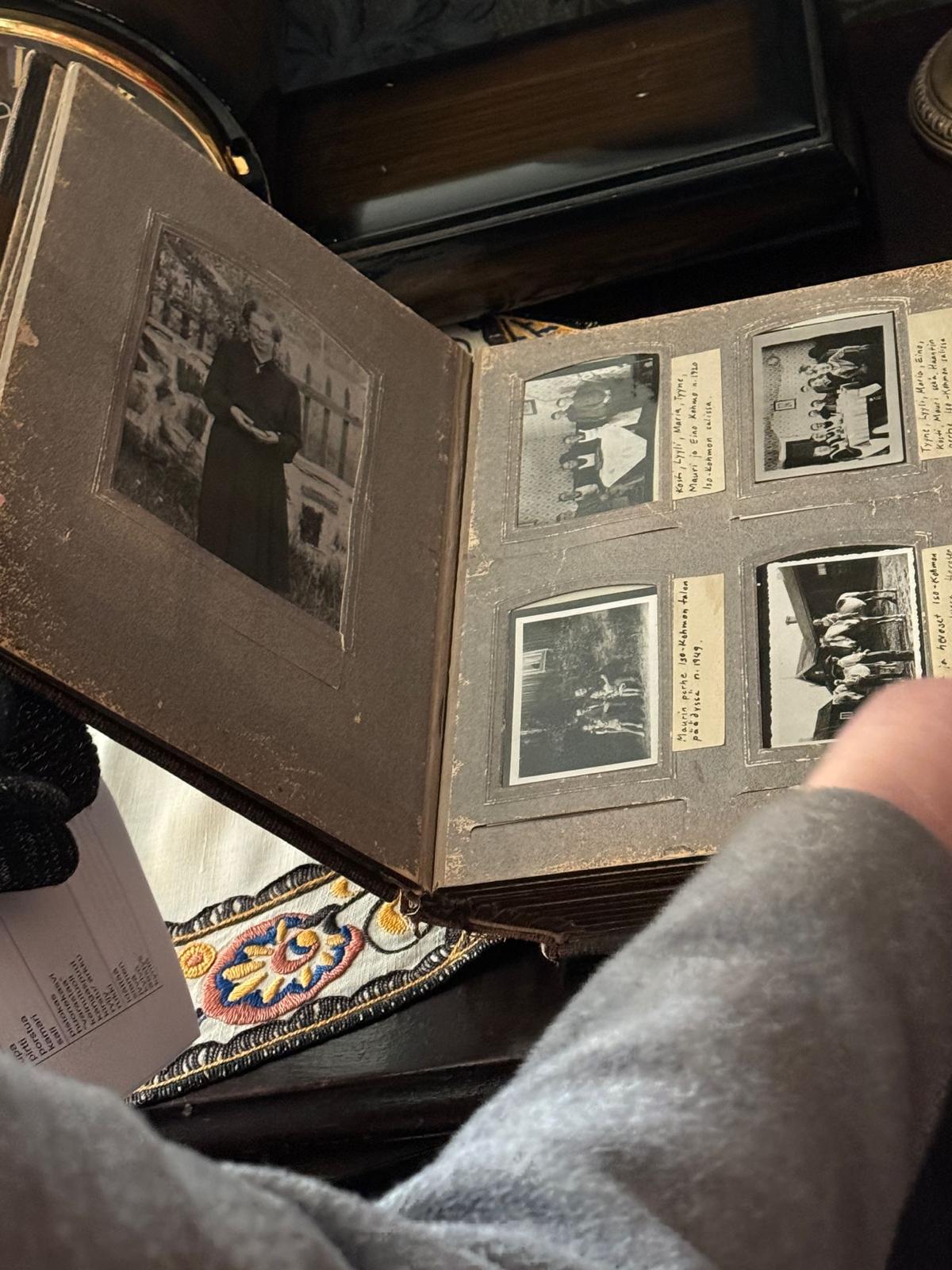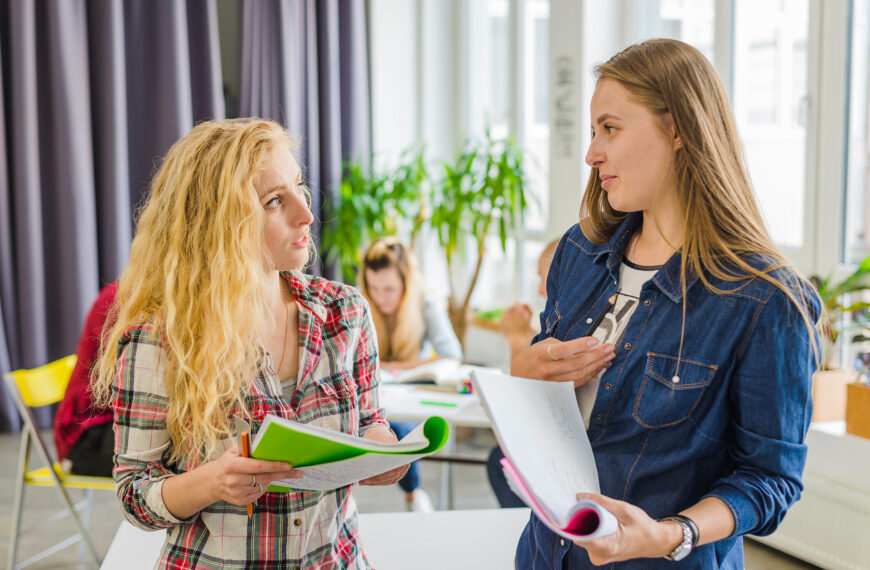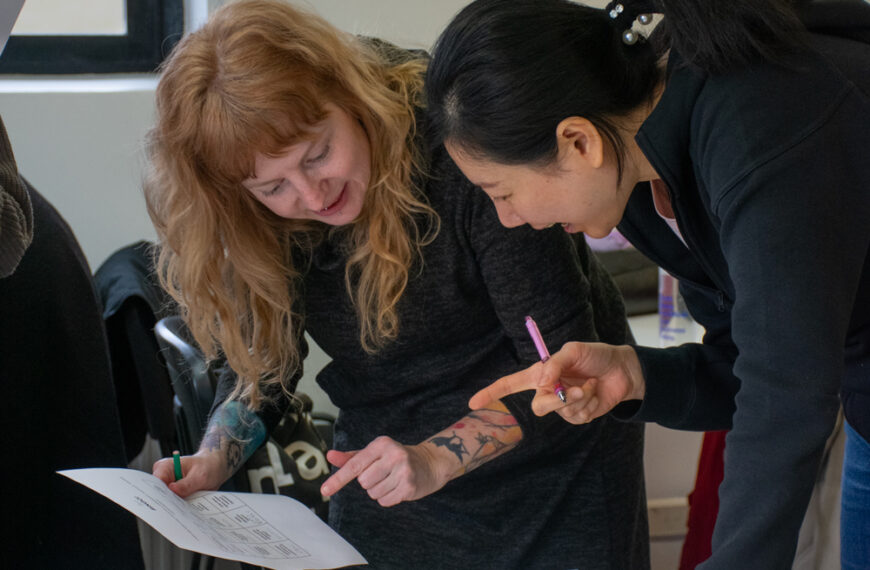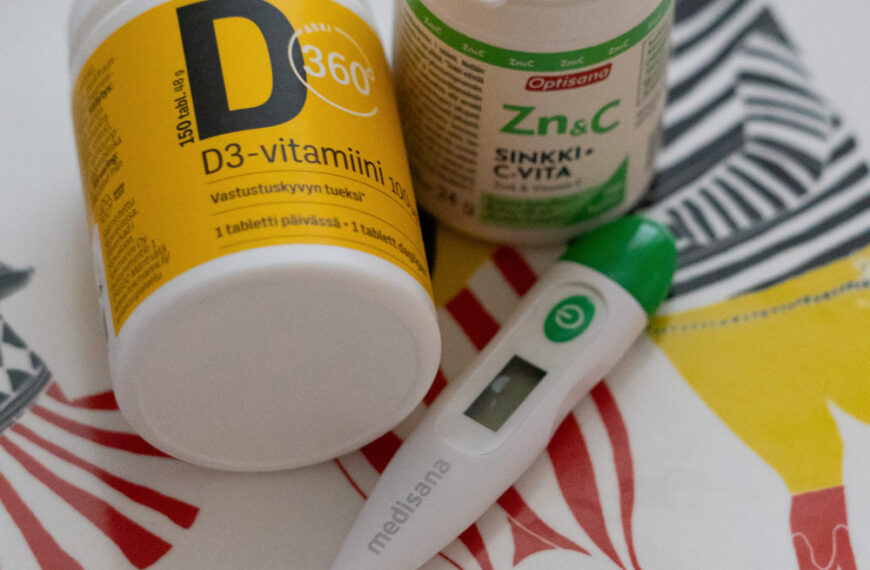A picture is worth a thousand words – but words are also needed!
In this easily variable exercise, the student has to talk about a single image for a certain amount of time. They can, for example, describe what they see or think, but the most important thing is to try to talk as much as possible. Everyone has their own turn to speak, so the exercise makes it easy to ensure that even the quieter ones can definitely be heard.
The purpose of the exercise is to get the students to produce a spontaneous speech on a certain theme. At the same time, you can also make observations about the level of your vocabulary.
Cover photo: Julia Melnyk
Produced by: PO / Niina Kuusivaara
Pair or small group exercise
Learning objectives:
- Description and narration
- Use or revise a selected dictionary theme
Instructions for this exercise
Prepare the exercise in advance, for example. PowerPoint. Search online sources for pictures that fit the topic of the lesson or current affairs, for example.
At the beginning of the exercise, the students are divided into pairs or small groups. They are told the idea of the task: in each group, one student at a time talks about the image on the screen for the entire given time (e.g. 1 min). When the picture changes, so does the speaker. If the speaker does not e.g. remember the right word, his partner/group can help him/her, but otherwise one person has the floor in the group at a time.
It is a good idea to put so many pictures in the exercise that each student gets to speak several times – often the speaking can only really get going after a few times!
Tip: The exercise also works well at higher levels of language proficiency. At the same time, students can observe how their vocabulary is sufficient to talk about the given topic.
Tips
Take some time to initialize the task: in this exercise, the most important thing is to try to produce as much speech as possible and speak the entire given time from one image. The student can, for example. describe what they have seen, tell their thoughts or even come up with a story.
You can either use the same amount of time all the time (e.g. 1 min/image) or you can slightly increase the duration with each round.
Variations
- Combine telling about the pictures with some grammatical thing, e.g. past tense.
- In different rounds, ask the students to pay attention to different factors of fluency in speaking: speed, pronunciation or, for example, accuracy.
Puhu kuvasta
Kuva kertoo enemmän kuin tuhat sanaa – mutta myös sanoja tarvitaan!
Tässä helposti varioitavassa harjoituksessa opiskelijan täytyy puhua tietty aika yhdestä kuvasta. Hän voi vaikkapa kuvailla näkemäänsä tai ajatuksiaan, mutta tärkeintä on yrittää puhua mahdollisimman paljon. Jokaisella on oma vuoronsa puhua, joten harjoituksen avulla on helppo varmistaa, että myös hiljaisemmat pääsevät varmasti ääneen.
Harjoituksen tarkoituksena on saada opiskelijat tuottamaan spontaania puhetta tietystä teemasta. Samalla voi tehdä havaintoja myös siitä, millaisella tasolla sanavarasto on.
Kansikuva: Julia Melnyk
Tehtävän tuottanut: PO / Niina Kuusivaara
Pari- tai pienryhmäharjoitus
Oppimistavoitteet:
- Kuvailu ja kertominen
- Valitun sanastoteeman käyttö tai kertaaminen
Ohjeet harjoitukseen
Valmistele harjoitus etukäteen esim. PowerPointin avulla. Etsi online-lähteistä kuvia, jotka sopivat tunnin aihepiiriin tai vaikkapa ajankohtaisiin asioihin.
Harjoituksen alussa opiskelijat jaetaan pareiksi tai pienryhmiin. Heille kerrotaan tehtävän idea: jokaisessa ryhmässä yksi opiskelija kerrallaan puhuu näytölle tulevasta kuvasta koko annetun ajan (esim. 1 min). Kun kuva vaihtuu, myös puhuja vaihtuu. Jos puhuja ei esim. muista oikeaa sanaa, hänen parinsa/ryhmänsä voi auttaa häntä, mutta muutoin puheenvuoro ryhmässä on kerrallaan yhdellä ihmisellä.
Kuvia kannattaa laittaa harjoitukseen niin monta, että jokainen opiskelija pääsee puhumaan useamman kerran – usein puhuminen pääsee kunnolla vauhtiin vasta muutaman kerran jälkeen!
Vinkki: Harjoitus toimii mainiosti myös korkeammilla kielitaidon tasoilla. Samalla opiskelijat voivat havainnoida, miten heidän sanavarastonsa riittää annetusta aiheesta puhumiseen.
Vinkkejä
Käytä hieman aikaa tehtävän alustamiseen: tässä harjoituksessa tärkeintä on yrittää tuottaa mahdollisimman paljon puhetta ja puhua koko annettu aika yhdestä kuvasta. Opiskelija voi esim. kuvailla näkemäänsä, kertoa ajatuksiaan tai keksiä vaikka tarinan.
Harjoituksessa voi joko käyttää koko ajan samaa aikaa (esim. 1 min/kuva) tai kestoa voi hieman lisätä jokaisella kierroksella.
Variaatioita
- Yhdistä kuvista kertominen johonkin kielioppiasiaan, esim. menneen ajan aikamuotojen käyttöön.
- Pyydä eri kierroksilla opiskelijoita kiinnittämään huomiota puhumisen eri sujuvuustekijöihin: nopeuteen, ääntämiseen tai esim. tarkkuuteen.
Parler d’une image
Une image vaut mille mots, mais les mots sont également nécessaires !
Dans cet exercice facilement modulable, l’apprenant.e doit parler d’une seule image pendant un certain temps. Il peut, par exemple, décrire ce qu’il/elle voit ou ce qu’il/elle pense, mais le plus important est d’essayer de parler le plus possible. Tout le monde dans la classe a son tour pour parler, ce qui permet de s’assurer que même les plus timides puissent s’exprimer.
Le but de l’exercice est d’amener les apprenant.es à produire un discours spontané sur un thème donné. En même temps, vous pouvez également faire des observations sur le niveau de leur vocabulaire, apporter des synonymes et corriger la prononciation.
Image de couverture : Julia Melnyk
Créé par : PO / Niina Kuusivaara
Exercice en binôme ou en petit groupe
Objectifs d’apprentissage:
- Description et narration
- Utiliser ou réviser du vocabulaire thématique
Consigne pour cet exercice
Préparez l’exercice à l’avance, par exemple sur PowerPoint. Recherchez des images en ligne qui correspondent au thème de la leçon ou à l’actualité, par exemple.
Au début de l’exercice, les apprenant.es sont réparti.es en binômes ou en petits groupes. On leur explique le principe de l’activité : dans chaque groupe, un.e apprenant.e à la fois, parle de l’image à l’écran pendant toute la durée impartie (par exemple 1 minute). Lorsque l’image change, l’orateur/l’oratrice change également. Si l’orateur ou l’oratrice ne se souvient pas du mot juste, son groupe ou partenaire peut l’aider, mais sinon, une seule personne à la fois a la parole dans le groupe.
Il est judicieux d’inclure suffisamment d’images dans l’exercice pour que chaque apprenant.e puisse s’exprimer plusieurs fois ; souvent, l’expression orale ne peut vraiment démarrer qu’après quelques essais!
Conseil : cet exercice fonctionne également très bien avec des niveaux de compétence linguistique plus élevés. Parallèlement, les apprenant.es peuvent observer dans quelle mesure leur vocabulaire est suffisant pour parler du sujet donné.
Conseils et astuces
Prenez le temps d’initialiser la tâche : dans cet exercice, le plus important est d’essayer de parler autant que possible et de parler pendant tout le temps imparti à partir d’une image. L’apprenant.e peut, par exemple, décrire ce qu’il a vu, exprimer ses pensées ou même inventer une histoire.
Vous pouvez soit utiliser le même temps à chaque fois (par exemple 1 minute par image), soit augmenter légèrement la durée à chaque tour.
Variations
- Combinez la description des images avec des notions grammaticales, par exemple le passé.
- Au cours de différentes séries, demandez aux apprenant.es de prêter attention à différents aspects de la fluidité à l’oral : la vitesse, la prononciation ou, par exemple, la précision.
Über das Bild sprechen
Ein Bild sagt mehr als tausend Worte – aber Worte sind auch wichtig!
Bei dieser leicht variablen Übung müssen die Schüler:innen eine bestimmte Zeit lang über ein einzelnes Bild sprechen. Sie können zum Beispiel beschreiben, was sie sehen oder denken, aber das Wichtigste ist, dass sie versuchen, so viel wie möglich zu sprechen. Jeder kommt einmal an die Reihe, sodass die Übung es leicht macht, sicherzustellen, dass auch die Stilleren auf jeden Fall zu Wort kommen.
Das Ziel der Übung ist es, die Schüler:innen dazu zu bringen, spontan über ein bestimmtes Thema zu sprechen. Gleichzeitig können Sie auch Beobachtungen zum Niveau Ihres Wortschatzes machen.
Titelbild: Julia Melnyk
Beigetragen von: PO / Niina Kuusivaara
Übungen zu zweit oder in kleinen Gruppen
Lernziele:
- Beschreibung und Erzählung
- Verwenden oder Bearbeiten eines ausgewählten Themas
Anleitung für diese Übung
Bereiten Sie die Übung im Voraus vor, zum Beispiel mit PowerPoint. Suchen Sie online nach Bildern, die zum Thema der Unterrichtsstunde oder zu aktuellen Ereignissen passen.
Zu Beginn der Übung werden die Schüler:innen in Paare oder kleine Gruppen aufgeteilt. Ihnen wird die Aufgabe erklärt: In jeder Gruppe spricht jeweils ein:e Schüler_in für die gesamte vorgegebene Zeit (z. B. 1 Minute) über das Bild auf dem Bildschirm. Wenn sich das Bild ändert, wechselt auch der Sprechende. Wenn der Sprechende sich beispielsweise nicht an das richtige Wort erinnern kann, kann ihm ein:e Partner:in/die Gruppe helfen, aber ansonsten hat jeweils nur eine Person in der Gruppe das Wort.
Es ist eine gute Idee, so viele Bilder in die Übung einzubauen, dass jede:r Schüler:in mehrmals zu Wort kommt – oft kommt das Sprechen erst nach einigen Malen richtig in Gang!
Tipp: Die Übung eignet sich auch gut für höhere Sprachkompetenzstufen. Gleichzeitig können die Schüler:innen beobachten, wie ihr Wortschatz ausreicht, um über das vorgegebene Thema zu sprechen.
Tipps
Nehmen Sie sich etwas Zeit, um die Aufgabe vorzubereiten: In dieser Übung ist es am wichtigsten, so viel wie möglich zu sprechen und die gesamte vorgegebene Zeit anhand eines Bildes zu füllen. Der Lernende kann beispielsweise beschreiben, was gesehen wurde, die Gedanken mitteilen oder sogar eine Geschichte erfinden.
Sie können entweder immer die gleiche Zeit verwenden (z. B. 1 Minute/Bild) oder die Dauer mit jeder Runde leicht erhöhen.
Variationen
- Kombinieren Sie das Erzählen über die Bilder mit einigen grammatikalischen Aspekten, z.B. der Vergangenheitsform.
- Bitten Sie die Schüler:innen in verschiedenen Runden, auf unterschiedliche Faktoren der Sprachgewandtheit zu achten: Geschwindigkeit, Aussprache oder beispielsweise Genauigkeit.
Una imagen vale más
Una imagen vale más que mil palabras, pero ¡también hacen falta palabras!
Para este ejercicio tan fácilmente variable, el alumno tiene que hablar sobre una sola imagen durante un tiempo determinado. Puede describir lo que ven o piensan, pero lo más importante es que hablen lo máximo posible. Cada uno tiene su turno para hablar, así que es fácil que hasta a los más tímidos se les preste atención.
El objetivo del ejercicio es que los alumnos produzcan un discurso espontáneo sobre un tema concreto. Al mismo tiempo, se puede observar el nivel de vocabulario.
Foto de portada: Julia Melnyk
Producido por: PO / Niina Kuusivaara
Ejercicio por parejas o grupos pequeños
Objetivos de aprendizaje:
- Descripción y narración
- Utilizar o reepasar un campo semántico seleccionado
Instrucciones del ejercicio
Instrucciones del ejercicio
Se prepara por adelantado, por ejemplo, una presentación de diapositivas. También se pueden buscar resucrsos online que ilustren la temática de la lección o alguna noticia.
Al inicio del ejercicio, los alumnos se dividen en parejas o grupos pequeños. Se les cuenta cómo funciona la tarea: por cada grupo, van hablando de uno en uno de la imagen de la pantalla durante el tiempo establecido (un minuto, por ejemplo). Cuando cambie la imagen, se pasa al siguiente miembro del equipo. Si alguien no recuerda una palabra, por ejemplo, sus compañeros pueden ayudar, pero si no es necesario, los demás no hablan.
Es buena idea que haya suficientes imágenes para que cada alumno hable varias veces. ¡Muchas veces no se sueltan hasta la segunda o la tercera vez!
Consejo: El ejercicio también funciona bien en niveles más avanzados, y los propios alumnos pueden comprobar si manejan el suficiente vocabulario para hablar sobre un tema determinado a bote pronto.
Consejos
- Tómate un tiempo para iniciar la tarea: en este ejercicio, lo más importante es tratar de hablar lo máximo posible y hablar durante todo el tiempo sobre una imagen. El alumno puede describir lo que ve, por ejemplo, opinar sobre lo que hay en la imagen o incluso inventarse una historia.
- Se puede usar la misma cantidad de tiempo cada vez, o ir aumentando el tiempo en cada ronda.
Variaciones
- Combina el hablar de las imágenes con un tema gramatical, como por ejemplo, que sea todo en pasado.
- Se les puede decir a los alumnos que se enfoquen en uno de los factores de fluidez hablada en cada ronda: velocidad, pronunciación o precisión.







